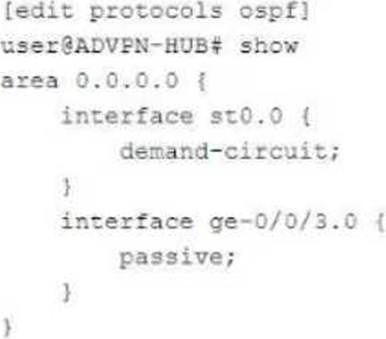Referring to the exhibit, which two statements under interface st0.0 on both the hub and spoke devices would solve this problem?
An ADVPN configuration has been verified on both the hub and spoke devices and it seems fine.
However, OSPF is not functioning as expected.

Referring to the exhibit, which two statements under interface st0.0 on both the hub and spoke devices would solve this problem? (Choose two.)
A . interface-type p2mp
B . dynamic-neighbors
C . passive
D . interface-type p2p
Answer: AB
Explanation:
For ADVPN with OSPF, using a point-to-multipoint (p2mp) interface type and enabling dynamic-neighbors are crucial. This configuration allows dynamic discovery of neighbors and the establishment of tunnels. For more information, refer to Juniper ADVPN Configuration Guide.
In the ADVPN configuration, OSPF isn’t functioning as expected due to the interface configuration on st0.0. Here are the adjustments needed:
Interface Type p2mp (Answer A): OSPF requires that the tunnel interface be set to p2mp (point-to-multipoint) to allow OSPF to communicate with multiple dynamic neighbors over the ADVPN tunnels.
Command Example:
bash
set interfaces st0.0 family inet ospf interface-type p2mp
Dynamic Neighbors (Answer B): The dynamic neighbors statement allows OSPF to discover and communicate with dynamically established spokes in an ADVPN environment. This is essential for ADVPN to function properly since the tunnel endpoints are not static.
Command Example:
bash
set protocols ospf area 0.0.0.0 interface st0.0 dynamic-neighbors
These settings ensure OSPF properly functions over dynamically created ADVPN tunnels.
Reference: Juniper ADVPN and OSPF configuration .
Latest JN0-637 Dumps Valid Version with 115 Q&As
Latest And Valid Q&A | Instant Download | Once Fail, Full Refund

